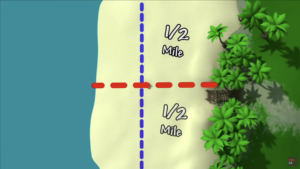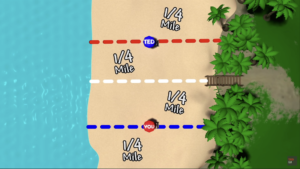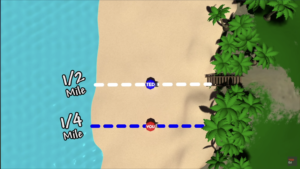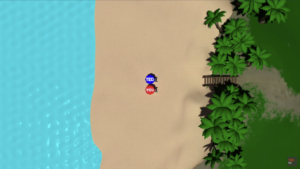Introduction
Have you visited a McDonald’s and noticed there is Burger King (or some other fast food restaurant) right across from it? Why is this the case? Why do we often see similar establishments in groups? Note that this does not only happen with fast food chains. We also see this happen with gas stations and coffee shops.
In this blog post, I go over how the principles behind Nash equilibrium provide an explanation for why this type of pattern occurs.
Ice Cream Cart Cousins
We can model the behaviour of these companies into a simpler model where two cousins sell the same type of ice cream on a mile-long beach. We will assume that customers are evenly distributed among this beach, and that customers will walk to the closet cart to get ice cream. In the beginning lets say only the first cousin decides to sell ice cream. When he arrives to the beach he sets his cart right at the center of beach. This way he maximizes sales because the maximum distance a customer will have to walk to reach his cart is half a mile:

After seeing the success of the first cousin, lets say the second cousin decides to bring his ice cream cart the second day. Being cousins they agree to split the beach evenly. The first cousin sets up his cart 0.25 miles north from the center and the second cousin sets up 0.25 miles south from the center. In this setup each cousins claim 50% of the customers on the beach. Both get 25% from their sides of the beach and they split the 50% of customers in the middle:
With that setup everyone should be happy right? If you stop and think about it, its actually not possible (assuming the cousins are rational and they want to maximize sales). The reason being is that the setup is not in Nash equilibrium. Lets say one of cousin realizes he can generate more sales and decides to setup his cart at the center of the beach. When this occurs, the cousin at the center now gets 62.5% of the customers. He gets 50% from all the customers north of his cart, and he shares the 25% of the customers located between his cart and his cousins’. Meanwhile the first cousin only gets 37.5% of the customers by having all the customers south of his cart and sharing the 25% customers located between his cart and his cousins’:

To counter this, the first cousin then decides to move his cart to the center of the beach. At this point both cousins are at the center, and both share all the customers on the beach. They both now get 50% percent of the customers on the beach. Neither cousin will now move their carts because doing so will decrease their sales. At this point we can say that the position of the carts are in Nash equilibrium.

With their final positions we see that both ice cream that sell the same cream ended up right next to each other at the center of the beach. This answers the questions for why similar stores end up being close to each other. The answer is has to do with Nash equilibrium. Both stores want to maximize their payoff and that leads them being close to each other.
Something interesting to note is that if the cousins originally just stayed at their original position of 0.25 miles north and 0.25 south from the center they still would have had 50% of customers. This setup also would have been better for the customers because it minimizes the distance they have to walk. However because both cousins know that they had the potential for higher sales by moving closer to the center it would have not been possible.
Links
- https://blogs.cornell.edu/info2040/2018/09/17/why-do-competitors-open-their-stores-next-to-one-another/
- https://www.youtube.com/watch?v=jILgxeNBK_8

2 replies on “Why are Similar Stores Often Close To Each Other”
Huh, intuitively I would think it would be worse off to be closer since you would have to compete with your close neighbor but with your explanation and reasoning with nash equilibrium, it actually does makes sense to stay closer. Good read!
Interesting post and great explanation! I had the same question before, but now I think I understand why this case happens after reading your explanation with Nash equilibrium.